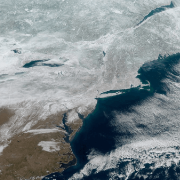-
Posts
34,462 -
Joined
-
Last visited
Content Type
Profiles
Blogs
Forums
American Weather
Media Demo
Store
Gallery
Everything posted by WxWatcher007
-

2025 Atlantic Hurricane Season
WxWatcher007 replied to BarryStantonGBP's topic in Tropical Headquarters
I mean recon was in there. It checked all the boxes. It was slop, but def a classic early season short fuse TC. -
Delayed but not denied
-
Just hit 90 here
-

2025 Atlantic Hurricane Season
WxWatcher007 replied to BarryStantonGBP's topic in Tropical Headquarters
I’m probably the biggest NHC naming defender here, but at least at the time it was named, Andrea was a joke. In the 24 hours or so before being named I recall that system being close to a TC, but when it was named it was little more than a swirl devoid of nearby convection. Barry was slop, which is what you’d expect in June, but it was legitimate. Recon found a sharp wind shift, there was persistent convection, and eventually recon sampled TS force wind. It made landfall as a depression. You’re not going to get a ton of ACE or eye candy from a subtropics swirl and a low that was the beneficiary of BoC magic in June. -
Yes—and likely in a significant way. Although there are other satellites that provide microwave data, losing these specific streams (which were delayed due to push back from folks within NHC/NOAA) will keep forecasters from being able to use microwave data in some instances to get a center fix or understand realtime changes occurring in a TC. Imagine what looks like a rapidly intensifying hurricane on our doorstep with recon six hours away, or a system that looks to be organizing at a faster clip or completing an eyewall replacement cycle. MW can get us real meaningful info when we need it. Also, the quality just isn’t as good at times due to where the scans occur. There’s that too. Lol
-
I'm not in a rural area by any means, but I still try to create an environment that doesn't disturb nature too much. The last two years I've had a resurgence of fireflies, rabbits, and pollinators. The fireflies have had a banner year so far. Not sure how much my mowing habits contribute lol.
-

2025 Atlantic Hurricane Season
WxWatcher007 replied to BarryStantonGBP's topic in Tropical Headquarters
Gulf or SE coast remains worth watching. The signal for genesis is still there with the GEFS focused in the Gulf and Euro focused off the SE coast. Either could be right. -
Coastal areas of the Gulf and SE are now a lemon.
-
Every year I say the GFS is getting better with tropical, and then it does this crap.
-
82/73
-
Tropical Depression Two Discussion Number 1 NWS National Hurricane Center Miami FL AL022025 400 PM CDT Sat Jun 28 2025 The area of low pressure that entered in the Bay of Campeche early this morning (Invest 91L) has slowly improved in organization through the day. Convection had been mostly bursting on the southern portion of the circulation, but is more recently starting to fill in over the northern side. An Air Force Reserve reconnaissance mission has been sampling the system this afternoon, and they were able to close off a circulation center, albeit with not a whole lot of wind. This wind field matches the satellite-derived scatterometer wind data at 1619 UTC which showed a closed circulation, but with peak winds of only 24 kt. However, given the improvement in convective organization with the well-defined circulation noted, advisories are being initiated on Tropical Depression Two this afternoon, with maximum sustained winds of 25 kt, matching the T1.5/25-kt estimate provided by TAFB. The initial motion of the tropical depression appears to be off to the west-northwest at 290/6 kt. This motion with a slight bend a little more northward is expected through the weekend until the system moves inland over mainland Mexico just after 36 h. The track guidance overall appears to be in pretty good agreement, though with the ECMWF on the south end and GFS on the north end of the guidance envelope. The initial NHC track forecast splits the difference and is quite close to the latest TVCN and HCCA consensus aids. The depression's wind field is still somewhat broad and in the formative stages. In addition, the environmental conditions are not ideal, with some 20-25 kt of west-southwesterly vertical wind shear diagnosed by SHIPS guidance that should prevent more robust intensification of this cyclone. On the other hand, sea-surface temperatures are fairly warm (28-29 C) and there is ample mid-level moisture to sustain the convective activity. Thus, some slow intensification seems likely, and the intensity forecast shows the depression becoming a tropical storm before making landfall in Mexico. However, once inland after 36 h, the system should quickly weaken and dissipate by the early portion of next week over the rugged high terrain of central Mexico. This intensity forecast is largely in good agreement with the consensus aid HCCA and the most recent HWRF hurricane-regional model run. Given the forecast for the depression to become a tropical storm before landfall, the government of Mexico has issued a Tropical Storm Warning for a portion of their eastern Gulf coastline. Key Messages: 1. Tropical Storm Conditions are expected on Sunday for portions of the Gulf coast of Mexico where a Tropical Storm Warning is in effect. 2. Heavy rainfall associated with Tropical Depression Two will impact portions of northeastern Mexico. This rainfall may produce isolated flash and urban flooding. FORECAST POSITIONS AND MAX WINDS INIT 28/2100Z 19.3N 94.2W 25 KT 30 MPH 12H 29/0600Z 19.7N 95.1W 30 KT 35 MPH 24H 29/1800Z 20.8N 96.1W 35 KT 40 MPH 36H 30/0600Z 21.9N 97.7W 35 KT 40 MPH 48H 30/1800Z 22.1N 98.7W 20 KT 25 MPH...POST-TROP/INLAND 60H 01/0600Z...DISSIPATED $$ Forecaster Papin
-

2025 Atlantic Hurricane Season
WxWatcher007 replied to BarryStantonGBP's topic in Tropical Headquarters
I agree. It looks like a western basin type of season… -
Looks like a pretty good wind shift to me. Probably will start getting advisories at 5 for a TD.
-
A perfect 4th is probably mostly sunny skies, 85/64 or thereabouts. Some years ago I was on a hill watching fireworks and there was a thunderstorm way off in the distance. Perfect evening, fireworks booming with actual long distance lightning strikes illuminating the storm. That was about as good as it gets.
-
GEFS and EPS With a sprawling Atlantic ridge, we may need to watch to see if something gets steered northward/NW if a system develops off the SE coast. Usually with a trough off the coast that creates enough of a weakness to allow for a SE homebrew system to escape, but if the ridge builds in fast enough it could cut off an escape route. The 12z Euro shows this with a weak system getting pushed into the SE. On the GFS, the system develops in the Gulf and heads west, also illustrating the potential blocking power of the ridge.
-

2025 Atlantic Hurricane Season
WxWatcher007 replied to BarryStantonGBP's topic in Tropical Headquarters
Just started a thread for 91L. It's also worth watching the Gulf and SE Coast next week for some homebrew potential. Both the GFS and Euro ensembles and operational models show a trough dipping in the south leading to TC genesis toward the latter part of next week. That's a climatologically favored genesis method, in addition to being in a climatologically favored region for TC development this time of year. It's also basically the only part of the basin not the subtropics that's warmer than normal. -
An organizing area of low pressure in the Bay of Campeche now has 70% odds of development, with tropical storm headlines likely later today or tonight. Although it will be short lived, a landfall is expected Monday along the coast of Mexico. Recon is en route to investigate. Tropical Weather Outlook NWS National Hurricane Center Miami FL 200 PM EDT Sat Jun 28 2025 For the North Atlantic...Caribbean Sea and the Gulf of America: Bay of Campeche (AL91): Recent surface observations, satellite imagery, and radar data from Mexico suggests a well-defined surface circulation is developing with the area of low pressure located in the Bay of Campeche near the Mexican coastline. In addition, shower and thunderstorm activity is also starting to show signs of organization. If these trends continue, a tropical depression is likely to form, possibly as soon as this afternoon, in the Bay of Campeche. This system is forecast to continue moving west-northwestward this weekend towards eastern Mexico, ultimately moving inland by Monday. An Air Force Reserve Hurricane Hunter aircraft is en route to investigate the system, and interests in southeastern Mexico should monitor the progress of this system. Tropical Storm Watches or Warnings could be required for portions of the Mexican Gulf coast as soon as this afternoon. Regardless of tropical cyclone formation, locally heavy rains are ongoing over portions of Guatemala and southeastern Mexico, and will continue during the next few days. * Formation chance through 48 hours...high...70 percent. * Formation chance through 7 days...high...70 percent. $$ Forecaster Papin
-
After a quiet start, the basin is starting to heat up with homebrew opportunities. For the first time we have tangible areas to look at close to land. 1. Invest 91L--Bay of Campeche magic is at it again, this time with a developing low taking shape this afternoon. Invest 91L is increasingly likely to become our second named storm of the year--a short lived one as it makes landfall along the Mexico coast on Monday. 2. Gulf/SE Coast--There are growing signals that a trough will get hung up off the Gulf/SE Coast in the coming week, which could spark tropical development. This is a classic way to get early season homebrew off the SE coast or in the northern Gulf, and it's worth watching especially if it ends up in the Gulf. The SST anomalies across the basin are unlike recent years, but in much of the Gulf and off the East Coast, temperatures are very warm.
-
The haters always said that forecasting was better 30 years ago…they’ll love it when the forecast is for 33 and rain and they wake up to 28 and ZR.
-

2025 Atlantic Hurricane Season
WxWatcher007 replied to BarryStantonGBP's topic in Tropical Headquarters
Yeah, pull the politics out of it—this sounds like a classic case of bureaucrats making decisions that don’t work in the real world. How many times have we sat here thinking tropical storm/hurricane X is “about to take off” or “is weakening due to an ERC” or “we need a center fix for the 00z models” only to have MW or recon data blow away our preconceived notions? I mean my goodness. Who wants to try to forecast if a cane off the east coast of Florida is about to undergo RI based on that quality of data below when recon is six hours away? -

2025 Atlantic Hurricane Season
WxWatcher007 replied to BarryStantonGBP's topic in Tropical Headquarters
Yeah about half of microwave imagery is gone as of Monday. It’ll have an immediate forecasting impact. -

2025 Atlantic Hurricane Season
WxWatcher007 replied to BarryStantonGBP's topic in Tropical Headquarters
What? That would be awful. -
I'm thinking this is a top 5 heat wave here in CT given the combination of high/low temperatures, humidity, and timing. Going in reverse chronological order June 2025 July 2011 July/August 1995 July 1991 July/August 1975 Edit: I'm thinking July 1911 should be somewhere in there, and if so, I'd probably take out 1995.
-
New Haven hit 99?
-
Yeah, it doesn’t seem out of step with the surrounding areas. A little surprised it didn’t get 100 yesterday, but like you said it was literally a degree. Anything can happen when trying to achieve 100 around here.







